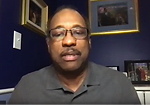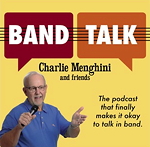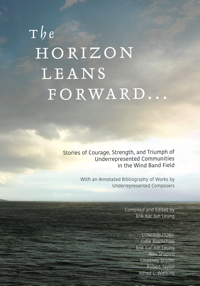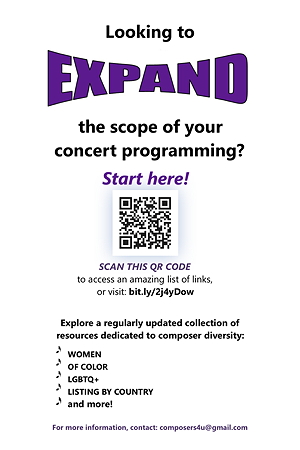
Looking to broaden the scope
|
EXPLORE THIS PAGE TO DISCOVER
|
|
|
Quick links on this page
|
WHAT'S THIS PAGE ABOUT?
|
Many conductors, directors, ensembles, and curators want to program the music of women, people who are non-binary, and composers of all racial, sexual, and ethnic identities, but sometimes don't know where to find these works, and don't have a lot of extra time to start looking. Thus, there's the very human tendency to program the composers and pieces that they already know.
|
|
|
It's not uncommon for someone to say, "I don't care about gender or race, I just want to program excellent music!". Absolutely: we can't think of anyone who would prefer to program non-excellent music. That's a perfectly reasonable sentiment, and in a perfectly balanced world this page of resources wouldn't be needed. Unfortunately at the moment, with only about 7% of all programmed concert and film music being composed by women, people of color, or those of alternate gender or sexual identities, it's actually very important to take diversity into account when choosing excellent repertoire. The people responsible for creating the music should be a reflection of the people playing it and listening to it! Unless the many wonderful pieces by currently underrepresented composers are able to be heard, few will know just how much terrific music is out there, and the significant imbalance will only perpetuate itself. It's easy to solve the problem! We call this, intentional programming. There's a LOT of excellent music being written by composers of all backgrounds-- it just takes an extra moment to discover these pieces. The many links on this page will help, and if you scroll lower down you can gather some easy, useful ideas. Relax, sit back, and enjoy clicking around and discovering fresh musical voices!
|
WHO'S THIS PAGE FOR?
|
This page is designed to be a resource for:
The thoughts included on this page are published with the intent for them to be useful talking points. Everyone, whether a musician or not, whether a high school student or a seasoned professional, can effect change by continuing to have conversations that raise awareness.
|
|
|

| WEB PAGES, GOOGLE DOCS, .PDFs: | ||
|
||
INSTITUTE FOR COMPOSER DIVERSITY An easily searchable database that allows conductors, performers, presenters, educators, and researchers to expand their scope of composers and repertoire. Read a January 2, 2018 article that Rob Deemer penned for Drew McManus's blog Adaptistration, explaining the process involved in creating this resource. Then, read Rob's follow-up article six months later in which he describes the process of the database expansion. |
 |
|
DIVERSE COMPOSERS OF WIND BAND MUSIC |
 |
|
|
An online resource for
wind band conductors, enthusiasts, and students featuring a great many sub-categories that make it easy to find composers of specific, diverse backgrounds. |
||
RESOURCES OF UNDERREPRESENTED COMPOSERS A collection of links to resources and information about composers from many backgrounds. |
 |
|
|
Giving underrepresented composers a platform to have their music heard, …And We Were Heard connects composers to ensembles which record these works so they can be more fully promoted. |
 |
|
|
Dedicated to working with diverse musical voices to create accessible educational music. |
 |
|
|
A guide to resources available for identifying and discussing music by marginalized composers (Black, Indigenous, POC, Women, LGBTQ+). |
||
MUSIC SOURCES FOR DIVERSITY, EQUITY, AND INCLUSION A guide from Rowan University that highlights resources for promoting DEI in music. |
||
|
||
WOODWIND MUSIC BY COMPOSERS IN UNDERREPRESENTED GROUPS Compiled by Bret Pimentel. |
||
|
Music for woodwinds. Compiled by Brandon Scott Rumsey. |
||
DIVERSITY IN CLARINET LITERATURE Clarinetist Kelsey Paquin's list of links to many useful resources, both general and clarinet-focused. |
||
|
Compiled by Ashley Killam. |
 |
|
|
Database of music for viola by underrepresented composers.
|
||
VIOLIN AND VIOLA MUSIC BY DIVERSE COMPOSERS Compiled by Lauren Bernofsky.
|
 |
|
|
Promoting inclusion in piano repertoire, this is a deep resource for pianists, pedagogues, and curious music appreciators to explore. |
 |
|
|
A growing collection of wind band concert programs which represent a diverse selection of composers. |
 |
|
|
Bandology highlights over 50 composers from communities which are too often underrepresented. The site also offers resources for educators and students to learn more about marginalized identities in composition, both in the past and present. Founded by Lisa Michaels and Peter VanDuzer. Bios HERE. |
||
DATABASES OF REPERTOIRE BY UNDERREPRESENTED COMPOSERS Orchestral repertoire, from the League of American Orchestras.
|
||
|
||
DONNE: WOMEN IN MUSIC Created by vocalist Gabriella Di Laccio. |
||
|
Promotes music composed by women through performance, education, research, consulting, and commissions. |
||
THE KAPRALOVA SOCIETY |
||
NEW YORK WOMEN COMPOSERS, INC. |
 |
|
|
The Corelia Project's mission is to elevate the voices of women and all marginalised genders in classical music through the performance and promotion of their works. |
 |
|
WOMEN'S PHILHARMONIC ADVOCACY |
 |
|
|
A French website offering many resources.
|
||
|
A German advocacy organization that features resources for discovering women composers.
|
 |
|
 |
||
|
MAESTRA features a database of women who make the music in the musical theater industry. Our membership is made up of female-identifying, non-binary, and gender non-conforming composers, music directors, orchestrators, arrangers, copyists, rehearsal pianists and other musicians who are an underrepresented minority in musical theater. |
||
|
A nonprofit organization with a large database that's helping to increase the number of women working in music – songwriters, engineers, producers, artists and industry professionals. |
 |
|
ALLIANCE FOR WOMEN FILM COMPOSERS A community of composers and colleagues who strive to support and celebrate the work of women composers through advocacy and education. |
 |
|
|
||
A DATABASE OF ART SONG BY WOMEN COMPOSERS A resource for musicians to aid in the discovery and celebration of art song by women composers.
|
||
|
Compiled by Ashley Ertz. |
 |
|
CLARINET WORKS BY FEMALE COMPOSERS Compiled by Erin Fung. |
 |
|
101 CLARINET COMPOSITIONS WRITTEN BY WOMEN COMPOSERS Compiled by Jenny Maclay. |
 |
|
|
An ongoing project meant to promote gender diversity in clarinet recital programming |
 |
|
WOMEN COMPOSERS CELLO COMPOSITIONS Compiled by Wendy Velasco. |
 |
|
WOMEN COMPOSER DATABASE OF WORKS FOR TROMBONE Compiled by Natalie Mannix. |
 |
|
INTERNATIONAL WOMEN'S BRASS CONFERENCE The list of brass works commissioned from women composers as part of the annual IWBC Composition Commission Projects.
|
||
WOMEN COMPOSERS OF WIND BAND MUSIC |
 |
|
DIVERSE COMPOSERS OF WIND BAND MUSIC |
 |
|
|
A growing list of women who compose for wind band, focusing on works
for playing grades I - IV. |
||
EUROPEAN FEMALE WIND BAND COMPOSERS A catalog of the results of research by Renata Oliveira at the Royal Conservatory of The Hague (The Netherlands).
|
|
|
|
||
THE COMPOSERS EQUITY PROJECT: A Database of ALAANA,* Women, and Gender Non-Conforming Composers. |
||
MUSIC OF ASIAN AMERICA RESEARCH CENTER The Music of Asian America Research Center (MAARC) strives to empower our communities through collecting, promoting, and teaching music created by Asian Americans. |
||
COMPOSERS DIVERSITY COLLECTIVE Created by composer Michael Abels. |
||
|
MBC's Living Composers Directory is designed for those seeking to commission; for performers, conductors, and concert programmers seeking existing music; and for other researchers and scholars of contemporary classical music. |
||
CASTLE OF OUR SKINS |
 |
|
AFRICAN AMERICAN COMPOSER INITIATIVE |
||
MUSIC BY BLACK COMPOSERS: AN INTRODUCTORY RESOURCE |
||
SPHINX: COMPOSER RESOURCES |
||
NATIVE AMERICAN COMPOSERS Written by Gail Wein, for NewMusicBox. |
||
AMERICAN INDIAN BAND MUSIC Created by composer Brent Michael Davids. |
 |
|
|
||
CLARINET WORKS BY BLACK COMPOSERS |
||
CLARINET MUSIC BY BLACK COMPOSERS |
||
STRING REPERTOIRE BY BIMOC Compiled by Gabriela Díaz. |
||
BEYOND ELIJAH ROCK: Created by composer Dr. Marques L. A. Garrett. |
||
 |
||
ORCHESTRAL MUSIC BY WOMEN OF AFRICAN DESCENT The Women's Philharmonic celebrates the vast range of orchestral music by women, and encourage orchestras to program it! All around us people are suddenly aware of long-ingrained sexist practices, and questioning their entrenched status. We work to reveal the centuries of music by women, much of it lost to history due to gender bias – and help provide information and resources to make that music available. |
 |
|
AMERICAN INDIAN BAND MUSIC Created by composer Brent Michael Davids. |
 |
|
|
||
QUEER BIO |
||
LGBTQ BAND COMPOSERS PROJECT |
||
10 CONTEMPORARY LGBTQ COMPOSERS YOU SHOULD KNOW |
||
LGBTQ+ MUSIC NOTABLE COMPOSERS |
||
15 LGBTQ+ COMPOSERS IN CLASSICAL MUSIC HISTORY THAT YOU PROBABLY ALREADY KNOW |
||
CLASSICAL QUEER |
||
|
||
MUSIC THEORY EXAMPLES BY WOMEN A database of excerpts and complete musical compositions by women composers. The music is categorized by theoretical concept for use in music education. |
 |
|
|
Resources to learn about the women that paved the way for future composers and performers of all genders. |
 |
|
EXPANDING THE MUSIC THEORY CANON Created by performer and educator Dr. Paula Maust. |
||
BLACK AND BROWN COMPOSERS |
||
COMPOSERS OF COLOR RESOURCE PROJECT A very helpful step towards diverse and inclusive music theory pedagogy, with many resources for music by composers of color. |
||
ELECTROACOUSTIC MUSIC OF BLACK COMPOSERS |
||
AFRICLASSICAL |
||
DIVERSE MUSIC THEORY EXAMPLES |
||
|
Transcriptions of rappers’ rhythms; charts of their harmonic progressions; and studies of the intricacy of their multilayered beat drops. |
||

|
||
CURATED PLAYLIST of women wind band composers. |
||
|
Watch this inspiring documentary short film about women composers in the film and video music world, from director Sara Nesson. |
||
LISTENING TO LADIES |
 |
|
|
Promoting academic inquiry into issues of gender and sexuality in the study of music. |
 |
|
CHAMPIONING DIVERSITY AND FAIRNESS FOR FILM/TV COMPOSERS ASCAP Experience: Home Edition convened a panel of award-winning composers who are leading the charge for diversity and equity in the screen music community: Starr Parodi, President of the Alliance for Women Film Composers, and Michael Abels, Co-Founder of the Composers Diversity Collective. They analyze the history of screen music's diversity problem, and talk about proactive measures the industry can take to work towards change. |
||
|
Helping music educators develop critical practices through research, training and discourse to build a more equitable future. |
 |
|
|
A weekly radio program devoted to the finest art music of the past and present composed by women. |
||
|
The Classical Queer podcast is a collaboration between Sammi Jane Smith & Jacob Edward Caines—musician, two queer people with widely differing interests & experience in classical music. |
||

There are at least four prongs to achieving a diverse musical community of composers, instrumentalists, conductors, and anyone else in the field. The responsibility is equally shared by: —Those who, through conversation, education, writing, and social media, can keep the realities of inequity in the public consciousness, It's important to note privilege: equal access is much easier to achieve with a modicum of financial stability. Many of the actions prescribed below assume at least a basic economic footing in society. If artists struggle to feed and house themselves, expenses like monthly internet fees, computer purchases, concert and conference tickets and the like are further from reach—but not impossible to grasp.
|
|
1. PERSISTENCE: Encourage your peers to join you in using the power of the pixel to raise everyone's consciousness about inequities. Part of the success of the #metoo movement has been the ongoing media coverage, making the issue unavoidable and part of the fabric of daily conversation. Use opportunities to converse, write, and post about the need for diversity.
|
|
2. AWARENESS and INTENT: Encourage those curating concerts and teaching in classrooms to practice intentional programming and to put thought into the lesson examples they select. With greater forethought, their concerts and classes will better reflect the diversity of their musicians, students, and audiences, and serve to inspire the next generation of composers. This is equally the case for required passages and pieces for performance competitions, as well as selections for inclusion on state lists. For those who work in educational institutions with limiting purchasing protocols, seek ways to circumnavigate the school's system in order to present students a broader selection of music not found on state lists, or accessed through large music retailers. One fast and highly effective way of diversifying a concert is for an ensemble director to use the power of Facebook or any interactive social media platform to crowd-source! Whenever someone posts a specific question like, "who are the female composers with short wind band fanfares" or, "give me the name of a composer of color who has an anthemic piece under 10 minutes with a big ending," etc., the responses pour in immediately and introduce everyone reading that thread to many terrific composers who were not previously on their radar.
|
|
3. ACTION: Encourage those on the inside of the circle to reach beyond its edges to talented individuals, and expose these newcomers to possibilities of which they might not be aware. Everyone was once an outsider. When established ensemble directors and composers meet newer composers, they can introduce these fresh faces to colleagues, let them know about opportunities, and encourage them to attend conferences and other events at which they can further build their own networks. It won't be long until those composers are doing the same for their peers. A supportive community is one of the best aspects of our expanding music world.
|
4. INITIATIVE: Encourage those who are not yet known to their established peers to take the initiative, and introduce themselves and their work. Below are a few effective things composers, conductors and others can do that will help them become part of the fabric of the professional world: —Attend concerts: —Attend conferences: —Be present in interactive online communities: —Get involved with music advocacy organizations:
|
|
|
A word about The vast majority of music curators are not intentionally discriminatory — it just doesn't occur to them to have a closer look at their programming choices. Yet a lack of purposeful inclusion usually ends up excluding anyone not already in a curator's immediate sphere. Think of swimming in tepid water: when the water is about the same temperature as our body, we're not really aware of it, because it's as though it's a part of us. The same thing is true for many conductors and ensemble leaders: when every composer they program looks like them, it's natural that they don't "see" the lack of composers with differing gender and racial identities— unless someone brings it to their attention.
|
|
A cautionary word about What's needed in the music field is the normalization of the presence of composers (and conductors and musicians, etc.!) from ALL backgrounds, equitably represented across the board. This is why ongoing diversity efforts are crucial to bringing unheard voices to the fore. But in the interest and best of intentions of reversing longstanding inequities, there is a potential danger in swinging the pendulum too far in the other direction when offering opportunity. It's neither productive nor ethical to be as adamantly non-inclusive of members of the current majority as that majority has historically been of the current minority. True diversity and inclusion is not achieved by completely excluding a portion of the artistic demographic. Embracing discriminatory practices does not create equity, it merely creates another version of imbalance. The pipeline of opportunity that has for so long shut out underrepresented artists, can be opened up without entirely turning off its existing intake valves. Regulating their throttle bit, perhaps, but not shutting them down. It's not necessary to deprive audiences of new compositional or conducting talents that happen to be attached to White men, when we have the ability to raise up all excellent new voices by rebalancing programs that used to be entirely White and male. Our goal is for the music of composers from ALL backgrounds to flow freely, side by side, and reach audiences with a powerful array of voices.
|
|
|
To this point, even the most well-meaning of curators can risk an appearance of insulting tokenism when, for instance, they opt to create an all-woman, or all-Black, or all-"Name Your Underrepresented Composer Here" concert— if they are not including plenty of works by such composers on their regularly programmed concerts. The gesture rings hollow. Self-isolation, -segregation, and -ghettoization make little sense when working to demonstrate that every composer from every background is equally excellent (and sometimes as equally mediocre!). A positive way to present a balanced program is to allow the pieces and the names of the composers to speak for themselves. Well meaning a gesture as it may be, calling out the presence of formerly underrepresented composers on a concert through promotional materials or when addressing an audience does the opposite of normalizing the work and instead, risks making these pieces appear more like a "special exhibit". Connecting audiences with the music of all composers is the goal. One engaging approach is to gather a short video from, or about, each composer on a program. Use it for PR leading up to the event, and play it for the audience at the event, either at the start, or as an introduction to each piece. The most supportive statement is made when the music from diverse composers is naturally presented alongside the equally worthy music from those who have historically been the majority. It's powerful for concertgoers to see creators from all backgrounds and periods together. This is what's meant by the term, normalization.
|
|
The new world of equal access: Until recently, the music of women and non-White people was not widely distributed. Concert repertoire remained the bastion of White men, with relatively few diverse composers included in the fabric of the canon. The latter part of the 20th century brought long overdue changes in society, and the advent of the internet suddenly offered artistic and financial freedom to composers of all backgrounds. As a result, the majority of repertoire from non-White-male composers is relatively new. This presents an additional programming hurdle for some curators: the need to include contemporary music on their programs. The boon in technology has changed the music world for the better, and offers all composers an equal opportunity to share their art. There are thousands of fresh musical voices of all races, genders, and sexual identities, and many of them are composing works of excellence. Now it's easier than ever to find the voices that speak to us, program those composers, and expose audiences to the music of their own time.
The joy of the future: Let's keep expanding these lists and expanding our awareness! This growing series of aggregated links aims to make it easy for everyone to experience the diversity of composers and the joys of their music. We look forward to a time not long from now when the term "underrepresented composers" becomes, "formerly underrepresented composers"!
|
|
|
Graduate Wind Conductors Assn.: Authors of The Horizon Leans Forward discuss the book March 2021 |
Hey Band! Network: Institute of Composer Diversity August 2020 |
WASBE Worldwide Winds series: Alex Shapiro with Emily Moss January 2021 |
|
Anti-Racism Music Resources,
|
|
|
|
September 2020
Alex Shapiro discusses diversity, equity and inclusion issues in the music field, with music education students at Rutgers University, with faculty hosts Todd Nichols and Kraig Williams. |
00:00: Historical context: technology advances assisting diversity
|
|
|
October 2020
The New York Chapter of the Recording Academy hosted a discussion about The Institute for Composer Diversity and its efforts, with Rob Deemer (Founder & Director of the Institute for Composer Diversity and Professor of Music Composition, SUNY Fredonia), Dr. Erik Leung (Directors of Bands, Music Dept, Oregon State University) and Alex Shapiro (Composer).
They discuss what makes the Institute unique, why it is necessary, and how it is engaging composers during the pandemic. The Institute for Composer Diversity is committed to the celebration, education, and advocacy of music created by composers from historically underrepresented genders, racial, ethnic, and cultural heritages, and sexual orientations as well as disabled composers.
|
|
|
March 2020
Beloved band director Charlie Menghini launched a new podcast series of conversations with composers, conductors, and educators, Band Talk with Charlie Menghini and Friends, and Alex Shapiro was the first of his guests for Episode 2. Charlie posed some direct questions about equity and diversity in concert programming, and Alex was delighted to have the opportunity to address them. To listen to that section of the podcast, please click below.
|
|
| Stream | ||
Stream
|
||
Download
|
||

|
|
A TOPICAL PUBLICATION
Alex Shapiro is one of six co-authors of the new book, The Horizon Leans Forward...Stories of Courage, Strength, and Triumph of Underrepresented Communities in the Wind Band Field, released by GIA Publications December 2020. Edited by conductor Erik Kar Jun Leung (Oregon State University), the book includes Ms. Shapiro's chapter, Reaching Out and Bringing Women In, along with those from composer Jodie Blackshaw and conductors Alfred L. Watkins, Robert Taylor (University of British Columbia), Courtney Snyder (University of Michigan), and Erik Leung, each of whom address perspectives of women, BIPOC, and LGBTQIA2S+ composers and conductors of the past and present.
Chapters address such topics as:
|
|
Racism and the Black experience in America and band music |
The intersection of Asian culture and a career in music |
The experiences and insights of esteemed female band directors |
Queer identity and visibility in the wind band world |
Encouragement, wisdom, and advice for empowering women in music |
Unique approaches to programming diverse works by diverse composers |
Additionally, the publication includes a notable GIA hosted a February 2021 webinar during which
|
|
|
In 2021 as part of the completion of his DMA in conducting at Northwestern University, former U.S. Air Force Band Principal Euphonium player Joseph Bello wrote a lecture/recital research document titled, RECOGNIZING UNDERREPRESENTED COMPOSERS IN THE WIND BAND COMMUNITY: FOSTERING DIVERSITY, EQUITY, AND INCLUSION (DEI). The paper concludes with two lengthy interviews: one with Erik Leung, the author and editor of The Horizon Leans Forward..., and another with one of the book's other five authors, Alex Shapiro. In her conversation with Mr. Bello Alex touched on a broad spectrum of DEI issues which you can read by clicking HERE.
|
|

PLEASE SHARE THE LINK
You can copy and paste: https://www.alexshapiro.org/ProgrammingResources.html Or if a shorter link to this page is helpful:
|
|
Spread awareness! Your voice is valuable!
|
|

|
|
HOW DID THIS PAGE COME TO BE?
I'm always delighted to see conductors and curators using their social media accounts to ask colleagues for repertoire suggestions from underrepresented composers. For several years, each time one of these inquiries popped up on my Facebook newsfeed, I'd reply by posting a few relevant links in their thread.
After doing this so many times that I'd created a copy/paste template to use for the occasions, in 2018 it dawned on me: I have my own web server and I program my own website, so I have a natural portal to create an ever-expanding collection of links and information.
I asked my dear friend and colleague Martha Mooke to look closely at my various drafts of content and design iterations. Once we felt the page did what it was intended to do, I launched it. All it took was a simple press of a key to give a broader platform to the tremendous effort that a great many dedicated people have put into creating these amazing resources.
It's thrilling to witness the hundreds of visitors coming to this page every month from around the world. Activism takes many forms, and sharing helpful information is among the easiest. It's something anyone can do, from anywhere. That includes YOU!
Alex Shapiro San Juan Island, Washington State, USA
|
|
|

©2025
by Alex Shapiro and Martha Mooke.
All rights reserved to design.








